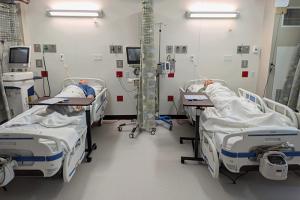Permitting processes and risk assessments

Work permitting and risk assessments are proactive approaches to identifying potential hazards and implementing preventive actions.
Image by Getty Images
Permitting processes and the use of risk assessments for work or projects within health care facilities are essential for managing risk and ensuring the safety of patients, staff and visitors.
They may include pre-construction risk assessments (PCRAs), infection control risk assessments (ICRAs), security risk assessments, interim life safety measures (ILSMs), and above-ceiling permitting and training, as well as activities related to utilities and mechanical systems, such as disruptions, testing and shutdowns, including hot work and confined space regulations.
A robust process
A robust permitting process helps identify and mitigate potential risks, such as those related to infection control, construction and environmental hazards, including operational vulnerabilities. Some key issues include:
PCRA and ICRA. PCRAs and ICRAs are documented multidisciplinary assessment processes intended to identify and mitigate infection risks that could occur during construction. These processes identify factors for the duration of work, locations, at-risk patients, the nature and scope of the project, and the functional implications to the facility.
A PCRA covers potential risks to patients, staff, visitors or assets related to air quality, infection control, utilities, noise, vibration or any other hazard applicable to the work. An ICRA determines the level of risk to patients and defines controls to reduce risk. The purpose of the risk assessment is to identify the effects of the construction or renovation activities on air and water quality.
The ICRA scores and matches activity types and patient risk groups and determines the potential risk in class of precautions. The class of precautions lists mitigation activities required to prevent the transmission of air, waterborne biological and surface contaminants in the facility. Working directly with the facility’s infection preventionist is critical. Additional controls include periodic inspections, noise, vibration, dust control, ventilation, pressurization, vertical shafts and elevators/stairs. Some resources include:
- The Facility Guidelines Institute’s Guidelines for Design and Construction of Health Care Facilities edition adopted by the facility’s authority having jurisdiction.
- The National Fire Protection Association’s NFPA 241-2009, Standards for Safeguarding Construction, Alteration and Demolition Operations, as referenced by the 2012 NFPA 101®, Life Safety Code®.
- The American Society for Health Care Engineering’s (ASHE’s) ICRA 2.0™ Matrix of Precautions for Construction, Renovation and Operations and ICRA 2.0™ Infection Control Risk Assessment and Permit (ASHE has made its tool and sample permit available to the public.)
Many times, infection control and life safety can conflict. Both are very important, so it’s essential to assess how conflicts can be resolved while limiting the impact on both. For example, alcohol-based hand rubs raise compliance considerations in the NFPA 101-2012 and accreditation standards regarding locations, quantities and storage in a smoke compartment. However, infection prevention focuses on preventing the spread of disease through hand-hygiene practices. Their locations help maintain hand-hygiene compliance and patient safety.
Life safety professionals should implement guidelines for storage, usage and dispensing to minimize fire risks while maintaining hand-hygiene standards. Working with infection prevention professionals in determining locations and the quantities allowed will maintain life safety and infection control requirements.
Another example are isolation precautions. These are put in place to prevent the spread of infectious diseases in the health care setting and are designed to protect health care workers and patients from exposure. At times, these precautions could conflict with life safety in maintaining clear egress pathways. Using proper signage, communication, training and drills can help alleviate these conflicts and maintain the required measures for life safety.
Collaboratively working with infection prevention professionals using clear communication is key to ensuring patient safety and compliance.
Security risk assessments. A security risk assessment identifies assets, vulnerabilities and threats to assets and finds reasonable risk mitigation strategies to protect patients, visitors and staff. This should include all organizational property, including parking lots, external structures and access roads.
Security risk assessments are required by most accrediting organizations. Regular evaluations of key factors like new construction, landscaping, lighting and camera placements help identify vulnerabilities before they become risks.
The following steps can be used for completing security risk assessments:
- Determine high-risk areas.
- Identify assets, vulnerabilities and threats.
- Assess risks.
- Determine, evaluate, implement and monitor countermeasures.
- Conduct a hazard vulnerability assessment (see related article below) and annual assessments.
Beyond compliance, a structured and comprehensive security risk assessment demonstrates a commitment to continuous improvement, ensuring that safety measures evolve alongside emerging internal and external threats.
Permitting and risk assessments are crucial components that ensure compliance with numerous regulations, requirements and standards, including those of accrediting organizations. This ensures protection of patients, visitors and staff and provides a safe and compliant environment.
ILSMs. ILSMs, alternate life safety measures (ALSMs) and temporary life safety measures (TLSMs) are used by various accrediting organizations. They are actions or measures put into place during construction, renovation and maintenance activities or any time deficiencies in the Life Safety Code cannot be corrected per the facility’s policy. ILSMs, ALSMs and TLSMs are safety measures developed by the health care organization. The accrediting organization requires an assessment to determine whether any measures are required.
When a building does not meet the applicable Life Safety Code during construction or renovations, or there is a potential for life safety to be disrupted (including a plan for improvement in the Statement of Conditions), facilities should assess and implement ILSMs as appropriate to compensate for the hazard. ILSMs are implemented to temporarily compensate for any hazard posed by life safety deficiencies to any building, grounds or environment.
Facilities can create and implement their own ILSMs as needed. Education and training can be accomplished during contractor safety meetings, maintenance staff meetings, workforce management software or other platforms for employee education and just-in-time training as specifics arise during inspections.
Above-ceiling permits. For projects, repairs and larger routine work such as pulling cable, it is necessary to maintain control of access to areas above ceilings to ensure life safety compliance and the integrity of fire/smoke barriers. Above-ceiling permits also are important for ensuring proper infection protocols.
Many facilities utilize an above-ceiling policy with an attached permit and accurate life safety drawings, including training on UL systems to be used and how to read the life safety drawings to ensure that maintenance staff, information technology staff, outside contractors and vendors performing work in the ceiling or on life safety fire/smoke barriers do so with advanced authorization from the facility.
These measures help ensure that contractors, maintenance, in-house construction and information services staff notify the issuer of the permit about the progress and locations of any work in the ceiling or on life safety fire/smoke barriers. Inspection should be completed by the issuer of the permit. This documentation also provides the issuer with a record of work to ensure correct UL systems are used for penetrations and routing of cabling and that systems are not supported by sprinkler piping.
Incoming electrical equipment. An incoming electrical equipment policy ensures patient and staff safety by requiring inspection, certification and proper use of all electrical devices. These can be brought in by materials management or other staff, patients or visitors. The policy’s goal is to prevent electrical hazards like shock, fire and malfunctioning equipment. They can vary by facility but usually include inventories, inspections, labeling and designated power strip usage.
Outlining goals for inspection, certification and use of electrical equipment should have a scope that defines the type of equipment, whether clinical or non-clinical. A process for inspecting new or incoming equipment should include extraction, transformation and loading; Food and Drug Administration regulations; and UL requirements for medical devices. The process should include the department that is responsible for the testing frequencies required for the devices. It also should have a standardized labeling system for both medical and non-medical devices, so they are easily recognizable and ensure staff are aware of the policies and know their procedures.
Disruptions and work scheduling. It sometimes is necessary to disrupt hospital operations by shutting down systems or utilities for testing, repairs, preventive maintenance, modifications and improvements.
Policies and permitting in this area are intended to minimize associated operational problems for building occupants and establish procedures for scheduling disruptions, testing and shutdowns. These can include, but are not limited to, disruptions to chilled and domestic water, electrical and other utilities, and nurse call systems due to boring, digging and other operations.
Some facilities use a 72-hour (i.e., three business days) notice on all disruption, testing and shutdowns, including approval for commencement of work. Some items included in the request would be the disruption/shutdown time and date. This type of form also could be used for larger maintenance activities or contractors who need to perform work at any site, including after business hours and on weekends and holidays.
Hot work. A hot work policy and permit system is an essential tool for minimizing the risk of fires and explosions during activities that include, but are not limited to, welding, cutting, brazing and soldering. It ensures that safety measures are taken and the work is performed in a controlled environment, preventing accidents and potential damage to property or injuries to workers. The permit is used as part of a documented system to ensure that only permitted work is done in a specific area by authorized personnel.
A hot work permit describes how the work is to be performed, when it must be completed and the precautions to be taken when working with high temperatures (e.g., welding, flame cutting, soldering, brazing, grinding or any use of an open flame). A reliable hot work permit process and workflow can prevent fires, explosions and many other risks. This program has been developed to prevent unauthorized entry, identify and evaluate confined space hazards, and establish procedures and practices for safe entry, including testing, monitoring and rescue.
Confined space entry. This assessment identifies potential hazards within a confined space to determine if it’s a permit-required space or a non-permit space. It aims to ensure safe entry and work practices in these environments.
A confined space has the following characteristics:
- Is large enough and configured so that an employee can bodily enter and perform assigned work.
- Has limited or restricted means for entry or exit.
- Is not designed for continuous employee occupancy.
A permit-required confined space has one or more of the following characteristics:
- Contains or has the potential to contain a hazardous atmosphere.
- Contains a material that has the potential for engulfing an entrant.
- Has an internal configuration so an entrant could be trapped or asphyxiated by inwardly converging walls or by a floor that slopes downward and tapers to a smaller cross-section.
- Contains any other recognized serious safety or health hazard.
A worksite evaluation should be conducted to determine if there are any permit-required confined spaces in the facility. All permit-required spaces should be posted with danger signs to alert employees to the existence, location and hazard involved (e.g., “DANGER PERMIT-REQUIRED CONFINED SPACE, DO NOT ENTER” and “DANGER CONFINED SPACE, CHECK POLICY FOR ENTRY INSTRUCTIONS”).
Authorized entrants, attendants and entry supervisors are required to receive training to ensure knowledge of duties and responsibilities during entry to confined spaces before being assigned such duties. The training shall establish employee proficiency in the required duties and that all training logs are maintained and easily accessible. The confined space supervisor will need to be familiar with the Occupational Safety and Health Administration’s OSHA 29 CFR 1910.146, Permit-required confined spaces.
A proactive approach
Work permitting and risk assessments are proactive approaches to identifying potential hazards and implementing preventive actions.
They help keep patients and staff safe, meet regulatory requirements, maintain infection controls and improve care.
An optimized and refined permit management and risk assessment system can improve efficiency, facilitate planning and identify problems before they arise.
Related article // Hazard vulnerability assessment risk identification and resources
A hazard vulnerability assessment (HVA) is a systematic process to help identify and analyze potential risks to a facility or organization as well as prioritize planning of mitigation, response and recovery activities.
The HVA process starts by forming a multidisciplinary team. This team includes clinical, administration, infection control, security and facilities management, although it is up to the facility to determine committee participants. The next step is identifying potential hazards that can be natural (e.g., hurricanes and earthquakes), technological (e.g., fires and power outages) or human caused (e.g., crimes or terrorist acts).
The HVA then helps determine how well an organization is prepared for potential emergencies. It involves classifying hazards, evaluating their potential impact and developing strategies to minimize risks.
Organizations are expected to have an HVA for locations within the organization or facility and the community. They should address potential emergencies that could affect demand for services and/or the ability to provide services. The HVA should factor in the likelihood of those events occurring and the consequences of those events.
There are several tools to assist a multidisciplinary group in assessing and prioritizing exercises for potential hazards or risks. These tools can help facilities develop the required documentation for accrediting organizations and compliance with the Centers for Medicare & Medicaid Services’ Conditions of Participation.
The HVA should be documented and reviewed at least every two years or as conditions change to ensure it remains current and relevant. By identifying and addressing potential risks and vulnerabilities, organizations can better prepare for and respond to emergencies, as well as facilitate a more efficient recovery process.
The resources below include Excel-based HVA tools that will score an emergency preparedness plan using the all-hazards approach and ensure the HVA covers a wide range of threats. The tools identify the potential hazards that need the most attention for exercise, planning, mitigation, response and recovery:
- The California Hospital Association’s Hospital Disaster Preparedness website.
- The Administration for Strategic Preparedness & Response’s Risk Identification and Site Criticality Toolkit 2.0.
- The American Society for Health Care Engineering’s Hazard Vulnerability Assessment Tool.
Mark Sears, CHFM, CHSP, SASHE, is manager of safety services at Faith Regional Health Services in Norfolk, Neb. He can be reached at msears@frhs.org.




